Android 多语言动态更新方案探索
本文首发于 vivo互联网技术 微信公众号
链接: https://mp.weixin.qq.com/s/jG8rAjQ8QAOmViiQ33SuEg
作者:陈龙
最近做的项目需要支持几十种语言,很多小语种在不认识的人看来跟乱码一样,,翻译一般是由翻译gongsi翻译的,翻译完成后再导入到项目里面,这就容易存在一些问题。
一、问题一:翻译容易出错
翻译的流程是客户端开发编写中文文案---翻译成英文----外包翻译根据英文字符串翻译小语种,在这个流程中,有些多义词和一些涉及语境的词就很容易翻译错误。
二、问题二:错误无法及时发现
前面说了,翻译gongsi提供回来的字符串我们都看不懂,错了也不知道,几乎都是上线之后,用户反馈过来,我们才知道。
因此小语种的翻译bug一直是项目里面比较多的一类bug,于是就需要探索一种可以用于动态更新翻译字符串的方案。
三、设计思路
在Android中,多语言字符串都是以各种不同文件夹下的xml保存的,每种文件夹中的限定符表示一种语言,这个一般Android的开发人员都是了解的。
如下图所示
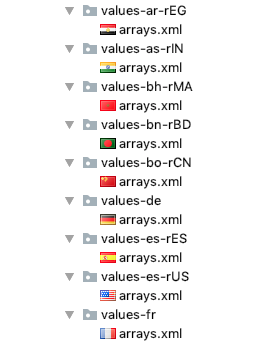
String文件作为Resource的一种,在使用时不管是layout中使用还是在java代码中使用其实都是调用Resource的各种方法。
那么其实翻译语言的动态更新实际上是Resource资源的替换更新。
在早些年的开发经验中,我们都知道有一种Android换主题的方案来给应用进行资源替换,简单来讲方案流程如下:
使用addAssertPath方法加载sd卡中的apk包,构建AsserManager实例。
AsserManager构建PlugResource实例。
使用装饰者模式编写ProxyResource,在各个获取资源的方法中优先获取PlugResource,获取不到再从备份的AppResource中获取。
替换Application和Activity中的Resource对象为ProxyResource。
继承LayoutInflater.Factory,拦截layout生成过程,并将资源获取指向ProxyResource,完成layout初始化。
既然有可参考的方案,那就可以直接开工了。
事实上在后续的开发过程中遇到很多细节问题,但万事开头难,我们可以先从第一步开始做起。
四、开发
流程一:从独立的plugapk包中取出PlugResources资源
AssetManager mLoadedAssetManager = AssetManager.class.newInstance();
Reflector.with(mLoadedAssetManager).method("addAssetPath", String.class).call(textResPath);
Resources textResPackResources = new Resources(mLoadedAssetManager, appResources.getDisplayMetrics(), appResources.getConfiguration());流程二:构建自己的TextResResources 实现getText等方法 将getText方法代理到PlugResources的getText
public class TextRepairProxyResourcess extends Resources {
private static final String TAG = "TextRepairProxyResourcess";
private Resources mResPackResources;
private Resources mAppResources;
private String mResPackPkgName;
public TextRepairProxyResourcess(AssetManager assets, DisplayMetrics metrics, Configuration config) {
super(assets, metrics, config);
}
public void prepare(Resources plugResources, Resources appResources, String pkgName) {
mResPackResources = plugResources;
mAppResources = appResources;
mResPackPkgName = pkgName;
}
private void printLog(String tag, CharSequence messgae) {
if (BuildConfig.DEBUG) {
VLog.d(tag, messgae + "");
}
}
@NonNull
@Override
public CharSequence getText(int resId) throws NotFoundException {
if (!checkNull()) {
return super.getText(resId);
} else if (!checkTextRepairOn()) {
return mAppResources.getText(resId);
} else {
CharSequence charSequence;
try {
int plugId = getIdentifier(resId);
if (plugId == 0) {
charSequence = mAppResources.getText(resId);
printLog(TAG, "getText res from app ---" + charSequence);
} else {
charSequence = mResPackResources.getText(plugId);
printLog(TAG, "getText res from plug ---" + charSequence);
}
} catch (Throwable e) {
charSequence = mAppResources.getText(resId);
if (BuildConfig.DEBUG) {
e.printStackTrace();
}
}
return charSequence;
}
}
@NonNull
@Override
public CharSequence[] getTextArray(int resId) throws NotFoundException {
.............
}
@NonNull
@Override
public String[] getStringArray(int resId) throws NotFoundException {
.............
}
@NonNull
@Override
public String getString(int resId) throws NotFoundException {
.............
}
@NonNull
@Override
public CharSequence getQuantityText(int resId, int quantity) throws NotFoundException {
.............
}
@NonNull
@Override
public String getQuantityString(int resId, int quantity, Object... formatArgs) throws NotFoundException {
.............
}
public int getIdentifier(int resId) {
if (!checkNull()) {
return 0;
} else {
// 有些情况就是很特殊 比如webView的34800147资源 使用mAppResources.getResourceEntryName会抛出
// notfound 异常 但是使用getString 却又可以拿到这个资源的字符串
try {
String resName = mAppResources.getResourceEntryName(resId);
String resType = mAppResources.getResourceTypeName(resId);
int plugId = mResPackResources.getIdentifier(resName, resType, mResPackPkgName);
return plugId;
} catch (Throwable e) {
return 0;
}
}
}
/**
* 有些方法是在super的构造方法里面调用的 需要判空处理
*
* @return
*/
private boolean checkNull() {
if (mAppResources != null && mResPackResources != null) {
return true;
} else {
return false;
}
}
/**
* 有些方法是在super的构造方法里面调用的 需要判空处理
*
* @return
*/
private boolean checkTextRepairOn() {
return TextRepairConfig.getInstance().isTextRepairOnThisSystem();
}
}流程三:Application启动的时候将Application的mResources对象Hook掉并设置TextResResources对象
Reflector.with(appContext).field("mResources").set(textRepairProxyResourcess);流程四:Activity启动的时候将Activity的mResources对象Hook掉并设置TextResResources对象
Reflector.with(activityContext).field("mResources").set(textRepairProxyResourcess);流程五:注册ActivtyLifecycleCallbacks 在onActivityCreated中对activity的LayoutInfater实现自己的Factory,在Factory中对text的Attribute的属性进行拦截并重新setText
public class TextRepairFactory implements LayoutInflater.Factory2 {
private static final HashMap<String, Constructor<? extends View>> mConstructorMap = new HashMap<>();
/**
* 系统调用的是两个参数的构造方法,我们也调用这个构造方法
*/
private static final Class<?>[] mConstructorSignature = new Class[] { Context.class, AttributeSet.class };
/**
* 一般 Android 系统的 View 都存储在这几个包下面
*/
private final String[] a = new String[] { "android.widget.", "android.view.", "android.webkit." };
// 属性处理类
TextRepairAttribute mTextRepairAttribute;
public TextRepairFactory() {
mTextRepairAttribute = new TextRepairAttribute();
}
@Override
public View onCreateView(View parent, String name, Context context, AttributeSet attrs) {
/*
* 我们模仿源码那样来创建 View
*/
View view = createViewFormTag(name, context, attrs);
/*
* 这里如果 View 返回的是 null 的话,就是自定义控件,
* 自定义控件不需要我们进行拼接,可以直接拿到全类名
*/
if (view == null) {
view = createView(name, context, attrs);
}
if (view != null) {
mTextRepairAttribute.load(view, attrs);
}
return view;
}
@Override
public View onCreateView(String name, Context context, AttributeSet attrs) {
return null;
}
private View createView(String name, Context context, AttributeSet attrs) {
Constructor<? extends View> constructor = findConstructor(context, name);
try {
return constructor.newInstance(context, attrs);
} catch (Throwable e) {
}
return null;
}
private Constructor<? extends View> findConstructor(Context context, String name) {
Constructor<? extends View> constructor = mConstructorMap.get(name);
if (null == constructor) {
try {
// 通过反射来获取 View 实例对象
Class<? extends View> clazz = context.getClassLoader().loadClass(name).asSubclass(View.class);
constructor = clazz.getConstructor(mConstructorSignature);
// 缓存View的class对象
mConstructorMap.put(name, constructor);
} catch (Throwable e) {
}
}
return constructor;
}
private View createViewFormTag(String name, Context context, AttributeSet attrs) {
// 包含自定义控件
if (-1 != name.indexOf('.')) {
return null;
}
View view = null;
for (int i = 0; i < a.length; i++) {
view = createView(a[i] + name, context, attrs);
if (view != null) {
break;
}
}
return view;
}
}public class TextRepairActivityLifecycle implements Application.ActivityLifecycleCallbacks {
@Override
public void onActivityCreated(Activity activity, Bundle savedInstanceState) {
LayoutInflater layoutInflater = LayoutInflater.from(activity);
TextRepairFactory textRepairFactory = new TextRepairFactory();
LayoutInflaterCompat.setFactory2(layoutInflater, textRepairFactory);
}
}但是真的就就这么简单吗?
上述几段代码就已经构成了资源替换的雏形,基本上完成了一个基础的资源替换流程。
再后续的调试点检过程种,我发现这才刚刚开始入坑。
五、探索
探索一:api 限制调用
demo一跑起来就发现log中打印诸多告警信息。
因为是使用反射的方法将Resource替换,因此也触发了Google的Api限制调用机制,于是研究了一下Api的限制调用。
结论:
系统签名应用暂时没有限制,因为demo使用的是调试签名,换用系统签名之后,告警消失。
探索二:性能测试
使用sd卡中的plugapk包生成PlugResources,主要是在生成assetManager过程,该过程耗时10-15ms,对于页面启动来说,这个时间还是太长了,于是尝试将AssetManager缓存起来,缩短了时间。
在反射替换resource完成后,调用PlugResources的getText方法,要先从本地Resources中根据Id获取原资源的name和type,然后在使用name和type调用getIndentifier获取PlugResources中的resId,这个过程耗时较长,虽然也是纳秒级别的,但其耗时比不hook场景下高一个数据级。
然而幸运的是,在页面流畅性性能测试中,并没有发现流畅性有所下降,页面启动速度也没有明显的下降。
探索三:系统版本兼容
真正的大坑来了。
解决完之前的问题之后,开始进入monkey测试,在测试中发现7.0以上的机器,只要在webView界面长按内容弹出复制粘贴对话框,就会崩溃从日志里面可以看出来是找不到webView的资源导致的,如果我try住这个崩溃,原资源位置显示的字符串就会变成类似@1232432这种id标签。
google搜索了半天,发现相关资料甚少,看来是需要从源码层面了解webView资源加载的相关逻辑才行。
看源码,总是需要带着问题去看,目标才够清晰。
问题:为什么6.0的系统可以使用这套方案而且不会有webView的问题而7.0以上的系统却会崩溃,6.0和7.0以上的资源管理有什么具体的区别。
想要得到答案 ,就得阅读6.0和7.0以上的Resource源码,先从6.0的源码看起。
1、6.0资源管理源码解析
Context初始化
private ContextImpl(ContextImpl container, ActivityThread mainThread,
LoadedApk packageInfo, IBinder activityToken, UserHandle user, boolean restricted,
Display display, Configuration overrideConfiguration, int createDisplayWithId) {
mOuterContext = this;
mMainThread = mainThread;
mActivityToken = activityToken;
mRestricted = restricted;
。。。。。。。。。。
Resources resources = packageInfo.getResources(mainThread);
if (resources != null) {
if (displayId != Display.DEFAULT_DISPLAY
|| overrideConfiguration != null
|| (compatInfo != null && compatInfo.applicationScale
!= resources.getCompatibilityInfo().applicationScale)) {
resources = mResourcesManager.getTopLevelResources(packageInfo.getResDir(),
packageInfo.getSplitResDirs(), packageInfo.getOverlayDirs(),
packageInfo.getApplicationInfo().sharedLibraryFiles, displayId,
overrideConfiguration, compatInfo);
}
}
mResources = resources;
。。。。。。。。。。。
}在Context创建之初,Resource就已经创建完成。
这里有两个地方涉及到了Resource创建
resources =packageInfo.getResources(mainThread);
resources =mResourcesManager.getTopLevelResources(packageInfo.getResDir(),
先从packageInfo.getResources(mainThread); 说起packageInfo 其实就是LoadedApk
packageInfo 的 getResources 方法
public Resources getResources(ActivityThread mainThread) {
if (mResources == null) {
mResources = mainThread.getTopLevelResources(mResDir, mSplitResDirs, mOverlayDirs,
mApplicationInfo.sharedLibraryFiles, Display.DEFAULT_DISPLAY, null, this);
}
return mResources;
}再看ActivityThread
ActivityThread 的 getTopLevelResources 方法
Resources getTopLevelResources(String resDir, String[] splitResDirs, String[] overlayDirs,
String[] libDirs, int displayId, Configuration overrideConfiguration,
LoadedApk pkgInfo) {
return mResourcesManager.getTopLevelResources(resDir, splitResDirs, overlayDirs, libDirs,
displayId, overrideConfiguration, pkgInfo.getCompatibilityInfo());其实调用的都是mResourcesManager.getTopLevelResources
Android M 的ResourcesManager写的比较简单
其内部有一个Resource缓存
getTopLevelResource 方法会使用传入的参数 组装一个key
ResourcesKey key = new ResourcesKey(resDir, displayId, overrideConfigCopy, scale);
使用这个key去缓存里面找,找到了就拿出来用。
WeakReference<Resources> wr = mActiveResources.get(key);
找不到就新创建一个assets 来生成一个Resource实例
AssetManager assets = new AssetManager();
if (resDir != null) {
if (assets.addAssetPath(resDir) == 0) {
return null;
}
}
if (splitResDirs != null) {
for (String splitResDir : splitResDirs) {
if (assets.addAssetPath(splitResDir) == 0) {
return null;
}
}
}
if (overlayDirs != null) {
for (String idmapPath : overlayDirs) {
assets.addOverlayPath(idmapPath);
}
}
if (libDirs != null) {
for (String libDir : libDirs) {
if (libDir.endsWith(".apk")) {
// Avoid opening files we know do not have resources,
// like code-only .jar files.
if (assets.addAssetPath(libDir) == 0) {
Log.w(TAG, "Asset path '" + libDir +
"' does not exist or contains no resources.");
}
}
}
}缓存的另一个作用就是configuration变化的时候 可以从缓存里面找到所有当前正在激活状态的Resource。
并且调用这些Resource的public void updateConfiguration(Configuration config,DisplayMetrics metrics, CompatibilityInfo compat) {方法,最终生效的是对Resource中的mAssets的configuration
再来看一下Resource.java
其核心包含两个部分
1:封装Assets,讲所有资源调用最终都是调用到mAssets的方法
public CharSequence getText(@StringRes int id) throws NotFoundException {
CharSequence res = mAssets.getResourceText(id);
if (res != null) {
return res;
}
throw new NotFoundException("String resource ID #0x" + Integer.toHexString(id));
}2:提供缓存
private static final LongSparseArray<ConstantState>[] sPreloadedDrawables;
private static final LongSparseArray<ConstantState> sPreloadedColorDrawables = new LongSparseArray<>();
private static final LongSparseArray<android.content.res.ConstantState<ColorStateList>> sPreloadedColorStateLists = new LongSparseArray<>();
private final DrawableCache mDrawableCache = new DrawableCache(this);
private final DrawableCache mColorDrawableCache = new DrawableCache(this);
private final ConfigurationBoundResourceCache<ColorStateList> mColorStateListCache = new ConfigurationBoundResourceCache<>(this);
private final ConfigurationBoundResourceCache<Animator> mAnimatorCache = new ConfigurationBoundResourceCache<>(this);
private final ConfigurationBoundResourceCache<StateListAnimator> mStateListAnimatorCache = new ConfigurationBoundResourceCache<>(this);
将从mAsserts中取出的大资源进行缓存,避免读取耗时和内存占用看完6.0的源码我们再找一份9.0的代码来看下,9.0的资源管理基本上与7.0一脉相承,因此我们直接使用了9.0的源码来进行分析。
相比于Android6.0 ,9.0源码中Resources中不在维护AssertManager 而是将AssertManager与其他的一些缓存 封装成了一个ResourcesImpl。
public class Resources {
static final String TAG = "Resources";
static Resources mSystem = null;
private ResourcesImpl mResourcesImpl;
private TypedValue mTmpValue = new TypedValue();
final ClassLoader mClassLoader;public class ResourcesImpl {
private static final LongSparseArray<Drawable.ConstantState>[] sPreloadedDrawables;
private static final LongSparseArray<Drawable.ConstantState> sPreloadedColorDrawables = new LongSparseArray<>();
private static final LongSparseArray<android.content.res.ConstantState<ComplexColor>> sPreloadedComplexColors = new LongSparseArray<>();
// These are protected by mAccessLock.
private final Configuration mTmpConfig = new Configuration();
private final DrawableCache mDrawableCache = new DrawableCache();
private final DrawableCache mColorDrawableCache = new DrawableCache();
private final ConfigurationBoundResourceCache<ComplexColor> mComplexColorCache = new ConfigurationBoundResourceCache<>();
private final ConfigurationBoundResourceCache<Animator> mAnimatorCache = new ConfigurationBoundResourceCache<>();
private final ConfigurationBoundResourceCache<StateListAnimator> mStateListAnimatorCache = new ConfigurationBoundResourceCache<>();
final AssetManager mAssets;
private final DisplayMetrics mMetrics = new DisplayMetrics();
private final DisplayAdjustments mDisplayAdjustments;
private PluralRules mPluralRule;
private final Configuration mConfiguration = new Configuration();
}ResourcesImpl 承担着老版本里面Resources的职责, 包装AssertManager 和 维护数据缓存。
而Resources的代码也变的更加简单,其方法调用最终都是交给了ResourcesImpl来实现。
不变的是Resources的管理还是要交给ResourcesManager来管理的,跟Android6.0一样ResourcesManager是一个单例模式。
那么9.0的ResourcesManager与6.0的ResourcesManager有和不同?
还是从应用启动开始看起,还是熟悉的ContextImpl。
2、9.0资源管理源码解析
static ContextImpl createAppContext(ActivityThread mainThread, LoadedApk packageInfo) {
if (packageInfo == null) throw new IllegalArgumentException("packageInfo");
ContextImpl context = new ContextImpl(null, mainThread, packageInfo, null, null, null, 0, null);
context.setResources(packageInfo.getResources());
return context;
}
static ContextImpl createActivityContext(ActivityThread mainThread, LoadedApk packageInfo, ActivityInfo activityInfo, IBinder activityToken, int displayId, Configuration overrideConfiguration) {
。。。。。。。。
ContextImpl context = new ContextImpl(null, mainThread, packageInfo, activityInfo.splitName, activityToken, null, 0, classLoader);
final ResourcesManager resourcesManager = ResourcesManager.getInstance();
context.setResources(resourcesManager.createBaseActivityResources(activityToken, packageInfo.getResDir(), splitDirs, packageInfo.getOverlayDirs(), packageInfo.getApplicationInfo().sharedLibraryFiles, displayId, overrideConfiguration, compatInfo, classLoader));
context.mDisplay = resourcesManager.getAdjustedDisplay(displayId, context.getResources());
return context;
}无论是生成Application的Resource还是生成Activity的Resource最终调用的是ResourceManager中的方法区别。在于一个调用的是
ResourcesManager.getInstance().getResources ,另一个调用的是resourcesManager.createBaseActivityResources。
OK 我们看一下ResourcesManager的源码。
先看下它提供的各种属性,我们挑重要的放上来。
/**
* ResourceImpls及其配置的映射。这些都是占用较大内存的数据
* 应该尽可能重用。所有的由ResourcesManager生成的ResourcesImpl都会被缓存在这个map中
*/
private final ArrayMap<ResourcesKey, WeakReference<ResourcesImpl>> mResourceImpls = new ArrayMap<>();
/**
*可以重用的资源引用列表。注意一下 这个list里面存储的并不是Activity的Resources缓存,按照我的理解,所有非Activcity的Resource都会被缓存在此处,比如Application的Resource
*/
private final ArrayList<WeakReference<Resources>> mResourceReferences = new ArrayList<>();
/**
* 每个Activity都有一个基本覆盖配置,该配置应用于每个Resources对象,而这些对象又可以指定自己的覆盖配置。
这个缓存里面保存的都是Actrivity的Resource的缓存,ActivityResources是一个对象,里面包含了一个Activity所拥有的Configuration和所有可能拥有过的Resources,比如一个Activity,在某些情况下他的ResourcesImpl发生了变化,那么这个时候就ActivityResources就可能会持有多个Resource引用
*/
private final WeakHashMap<IBinder, ActivityResources> mActivityResourceReferences = new WeakHashMap<>();
/**
* 缓存的ApkAssets,这个可以先不看
*/
private final LruCache<ApkKey, ApkAssets> mLoadedApkAssets = new LruCache<>(3);
/**
* 这也是ApkAssets的一个缓存 这个也可以先不看
*/
private final ArrayMap<ApkKey, WeakReference<ApkAssets>> mCachedApkAssets = new ArrayMap<>();
private static class ApkKey {
public final String path;
public final boolean sharedLib;
public final boolean overlay;
}
/**
* 与Activity关联的资源和基本配置覆盖。
*/
private static class ActivityResources {
public final Configuration overrideConfig = new Configuration();
//按照常规的理解 一个Activity只有一个Resources 但是这里却使用了一个list来存储,这是考虑如果Activity发生变化,重新生成了Resource,这个列表就会将Activity历史使用过的Resources都存在里面,当然,如果没有人再持有这些Resources,就会被回收
public final ArrayList<WeakReference<Resources>> activityResources = new ArrayList<>();
}了解了这些重要的属性之后,我们再来看一下ResourceManager提供的诸多方法。
ResourceManager提供了如下以写public方法供调用。
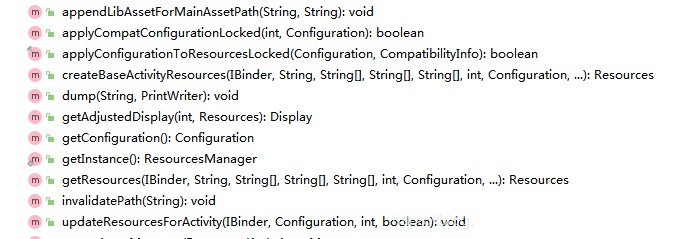
先看getResources和createBaseActivityResources 最终都是使用一个ResourcesKey去调用getOrCreateResources。
Resources getResources(@Nullable IBinder activityToken, @Nullable String resDir, @Nullable String[] splitResDirs, @Nullable String[] overlayDirs, @Nullable String[] libDirs, int displayId, @Nullable Configuration overrideConfig, @NonNull CompatibilityInfo compatInfo, @Nullable ClassLoader classLoader) {
try {
final ResourcesKey key = new ResourcesKey(resDir, splitResDirs, overlayDirs, libDirs, displayId, overrideConfig != null ? new Configuration(overrideConfig) : null,compatInfo);
classLoader = classLoader != null ? classLoader : ClassLoader.getSystemClassLoader();
return getOrCreateResources(activityToken, key, classLoader);
} finally {
}
}Resources createBaseActivityResources(@NonNull IBinder activityToken, @Nullable String resDir, @Nullable String[] splitResDirs, @Nullable String[] overlayDirs, @Nullable String[] libDirs, int displayId, @Nullable Configuration overrideConfig, @NonNull CompatibilityInfo compatInfo, @Nullable ClassLoader classLoader) {
try {
final ResourcesKey key = new ResourcesKey(resDir, splitResDirs, overlayDirs, libDirs, displayId, overrideConfig != null ? new Configuration(overrideConfig) : null, compatInfo);
classLoader = classLoader != null ? classLoader : ClassLoader.getSystemClassLoader();
synchronized (this) {
// 强制创建ActivityResources对象并放到缓存里面
getOrCreateActivityResourcesStructLocked(activityToken);
}
// 更新任何现有的Activity Resources引用。
updateResourcesForActivity(activityToken, overrideConfig, displayId, false /* movedToDifferentDisplay */);
// 现在请求一个实际的Resources对象。
return getOrCreateResources(activityToken, key, classLoader);
} finally {
}
}getOrCreateResources 我在各行代码处都写了注释,大家注意看代码中的注释,部分注释是对代码中引文注释的翻译。
private @Nullable
Resources getOrCreateResources(@Nullable IBinder activityToken, @NonNull ResourcesKey key, @NonNull ClassLoader classLoader) {
synchronized (this) {
if (activityToken != null) {
final ActivityResources activityResources = getOrCreateActivityResourcesStructLocked(activityToken);
// 清理已经被回收的缓存
ArrayUtils.unstableRemoveIf(activityResources.activityResources, sEmptyReferencePredicate);
// Rebase the key's override config on top of the Activity's base override.
if (key.hasOverrideConfiguration() && !activityResources.overrideConfig.equals(Configuration.EMPTY)) {
final Configuration temp = new Configuration(activityResources.overrideConfig);
temp.updateFrom(key.mOverrideConfiguration);
key.mOverrideConfiguration.setTo(temp);
}
//根据对应的key 去获取一个ResourcesImpl 有可能是新的也有可能是缓存里面的
ResourcesImpl resourcesImpl = findResourcesImplForKeyLocked(key);
if (resourcesImpl != null) {
//使用ResourcesImpl 去生成一个Resources
return getOrCreateResourcesForActivityLocked(activityToken, classLoader, resourcesImpl, key.mCompatInfo);
}
// We will create the ResourcesImpl object outside of holding this lock.
} else {
// 清理 因为mResourceReferences里面放的都是弱引用,要判断这些弱引用是否都已经被释放,如果释放的话就要从Array里面移除掉
ArrayUtils.unstableRemoveIf(mResourceReferences, sEmptyReferencePredicate);
// 不依赖于Activity,找到具有正确ResourcesImpl的共享资源 这里就是根据key去mResourceImpls的缓存里面找
ResourcesImpl resourcesImpl = findResourcesImplForKeyLocked(key);
if (resourcesImpl != null) {
//如果找到resourcesImpl的话就去从mResourceReferences看有没有可用的resources 如果类加载器和ResourcesImpl相同,则获取现有的Resources对象,否则会创建一个新的Resources对象。
return getOrCreateResourcesLocked(classLoader, resourcesImpl, key.mCompatInfo);
}
// 我们将在持有此锁之外创建ResourcesImpl对象。
}
// 如果我们走到了这里,我们找不到合适的ResourcesImpl来使用,所以现在创建一个。
ResourcesImpl resourcesImpl = createResourcesImpl(key);
if (resourcesImpl == null) {
return null;
}
// 将此ResourcesImpl添加到缓存中。
mResourceImpls.put(key, new WeakReference<>(resourcesImpl));
final Resources resources;
if (activityToken != null) {
//从mActivityResourceReferences 里面去找 看有没有合适的Resources可用 如果没有就构建一个Resources兵添加到mActivityResourceReferences里面
resources = getOrCreateResourcesForActivityLocked(activityToken, classLoader, resourcesImpl, key.mCompatInfo);
} else {
//使用创建出来的ResourcesImpl去匹配一个Resource,具体是从缓存mResourceReferences里面取(如果有的话)还是创建新的由下面的方法决定
resources = getOrCreateResourcesLocked(classLoader, resourcesImpl, key.mCompatInfo);
}
return resources;
}
}画个流程图看下

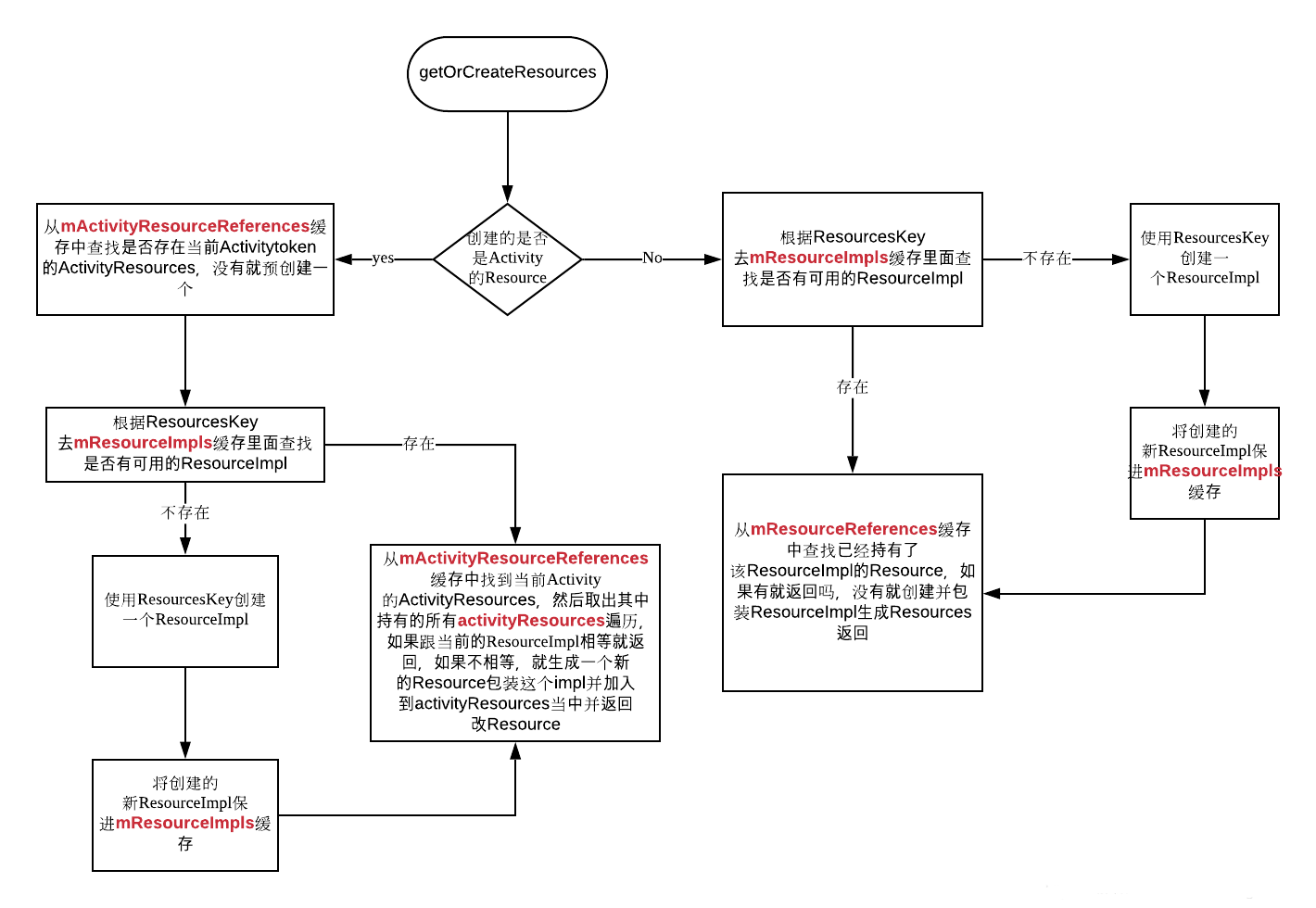
看完这个图基本上大体的逻辑就通我们使用如下的代码 hook 系统ResourcesManger的几个缓存 看一下当一个App启动并且打开一个Activity时,这些缓存里面都包含了哪些对象。
try {
System.out.println("Application = " + getApplicationContext().getResources() + " 持有 " + Reflector.with(getApplicationContext().getResources()).method("getImpl").call());
System.out.println("Activity = " + getResources() + " 持有 " + Reflector.with(getResources()).method("getImpl").call());
System.out.println("System = " + Resources.getSystem() + " 持有 " + Reflector.with(Resources.getSystem()).method("getImpl").call());
ResourcesManager resourcesManager = ResourcesManager.getInstance();
System.out.println("--------------------------------mResourceImpls----------------------------------------------");
ArrayMap<ResourcesKey, WeakReference<ResourcesImpl>> mResourceImpls = Reflector.with(resourcesManager).field("mResourceImpls").get();
Iterator<ResourcesKey> resourcesKeyIterator = mResourceImpls.keySet().iterator();
while (resourcesKeyIterator.hasNext()) {
ResourcesKey key = resourcesKeyIterator.next();
WeakReference<ResourcesImpl> value = mResourceImpls.get(key);
System.out.println("key = " + key);
System.out.println("value = " + value.get());
}
System.out.println("-----------------------------------mResourceReferences-------------------------------------------");
ArrayList<WeakReference<Resources>> mResourceReferences = Reflector.with(resourcesManager).field("mResourceReferences").get();
for (WeakReference<Resources> weakReference : mResourceReferences) {
Resources resources = weakReference.get();
if (resources != null) {
System.out.println(resources + " 持有 " + Reflector.with(resources).method("getImpl").call());
}
}
System.out.println("-------------------------------------mActivityResourceReferences-----------------------------------------");
WeakHashMap<IBinder, Object> mActivityResourceReferences = Reflector.with(resourcesManager).field("mActivityResourceReferences").get();
Iterator<IBinder> iBinderIterator = mActivityResourceReferences.keySet().iterator();
while (iBinderIterator.hasNext()) {
IBinder key = iBinderIterator.next();
Object value = mActivityResourceReferences.get(key);
System.out.println("key = " + key);
System.out.println("value = " + value);
Object overrideConfig = Reflector.with(value).field("overrideConfig").get();
System.out.println("overrideConfig = " + overrideConfig);
Object activityResources = Reflector.with(value).field("activityResources").get();
try {
ArrayList<WeakReference<Resources>> list = (ArrayList<WeakReference<Resources>>) activityResources;
for (WeakReference<Resources> weakReference : list) {
Resources resources = weakReference.get();
System.out.println("activityResources = " + resources + " 持有 " + Reflector.with(resources).method("getImpl").call());
}
} catch (Reflector.ReflectedException e) {
e.printStackTrace();
}
}
} catch (Exception e) {
e.printStackTrace();
}打印出来的结果如下图:

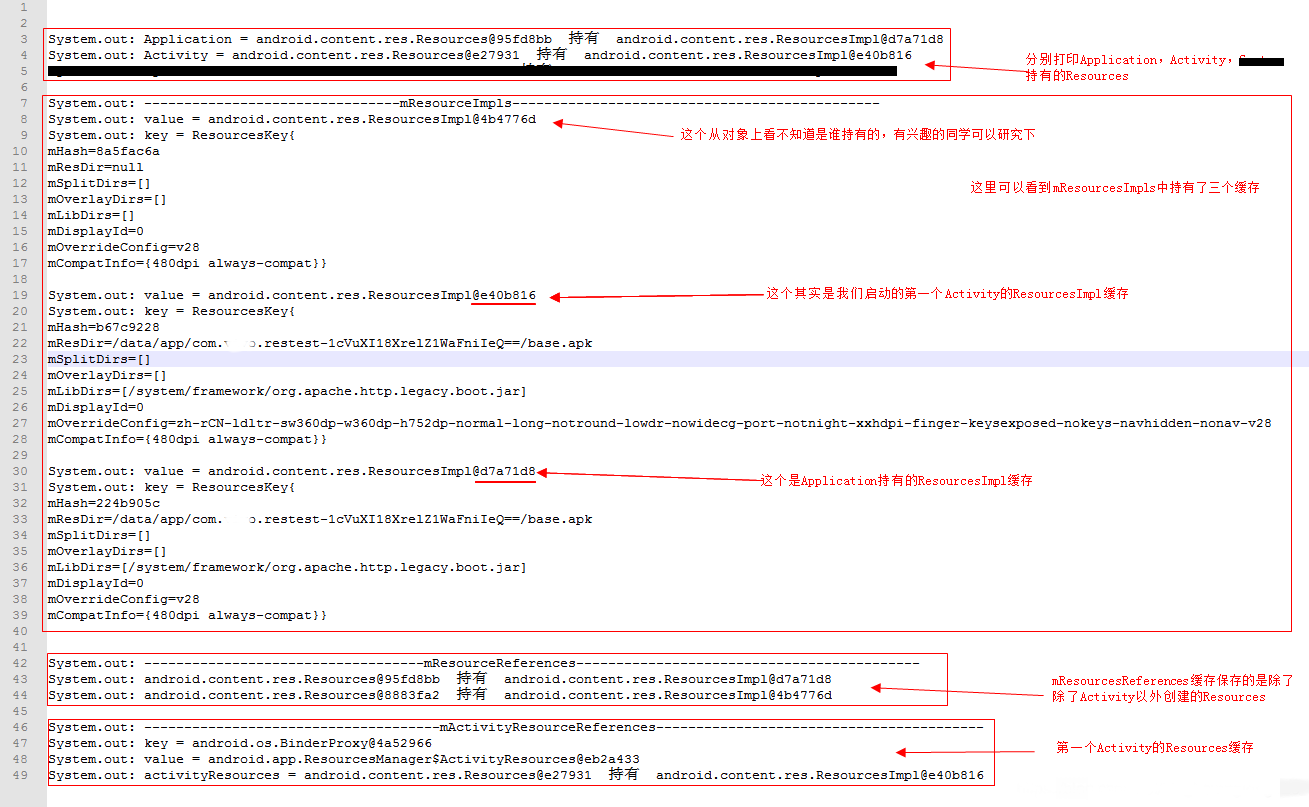
分析完两个不同api level的资源管理源码,我们再来分析一下两个不同apiLevel在加载完成一个webView组件之后Resource的区别。
先说以下6.0的 。
根据6.0 ResourceManager的代码 我们先做一个测试:
编写如下代码 我们将mActiveResources中保存的内容打印出来。
3、6.0 web资源注入分析
ResourcesManager resourcesManager = ResourcesManager.getInstance();
//6.0打印
try {
ArrayMap<Object, WeakReference<Object>> map = Reflector.with(resourcesManager).field("mActiveResources").get();
for (int i = 0; i < map.size(); i++) {
Object a = map.keyAt(i);
Object b = map.valueAt(i).get();
System.out.println(Reflector.with(a).field("mResDir").get());
System.out.println(b.toString());
}
} catch (Exception e) {
e.printStackTrace();
}打印输出
10-12 15:47:02.816 10785-10785/com.xxxx.res_manager_study I/System.out: /data/app/com.xxxx.res_manager_study-1/base.apk
10-12 15:47:02.816 10785-10785/com.xxxx.res_manager_study I/System.out: android.content.res.Resources@f911117可以看到当前包的Resources已经被加入到mActiveResources中了。
再修改代码:
在打印之前添加webView初始化 WebView webView = new WebView(context);
打印输出:
10-12 15:48:48.586 10985-10985/com.xxxx.res_manager_study I/System.out: /data/app/com.google.android.webview-1/base.apk
10-12 15:48:48.586 10985-10985/com.xxxx.res_manager_study I/System.out: android.content.res.Resources@9bc9c4
10-12 15:48:48.586 10985-10985/com.xxxx.res_manager_study I/System.out: /data/app/com.xxxx.res_manager_study-2/base.apk
10-12 15:48:48.586 10985-10985/com.xxxx.res_manager_study I/System.out: android.content.res.Resources@b66d0ad可以看到添加了webView初始化代码之后 mActiveResources中增加了一个Resources实例,该实例指向webView组件安装路径。
WebView就是从这个Resources取到了自己所需要的资源。这也是7.0以下版本中替换Activity和Application的Resources不会出现Web组件崩溃的原因,因为在这个level的系统中,web组件资源与主apk资源是分离的。
OK 分析完6.0的再看9.0的。
9.0的ResourceManager相对复杂,我们也是使用反射的方法将两种情况下的ResourceManager数据打印出来。
编写打印代码。
4、9.0 web资源注入分析
System.out.println(" 打印 mResourceImpls 中缓存的 ResourceImpl");
ResourcesManager resourcesManager = ResourcesManager.getInstance();
// 9.0源码
try {
ArrayMap map = Reflector.with(resourcesManager).field("mResourceImpls").get();
for (int i = 0; i < map.size(); i++) {
Object key = map.keyAt(i);
WeakReference value = (WeakReference) map.get(key);
System.out.println(value.get() + " " + key);
}
} catch (Reflector.ReflectedException e) {
e.printStackTrace();
}
System.out.println(" 打印 mActivityResourceReferences 中缓存的 Activity Resources");
try {
WeakHashMap<Object, Object> map = Reflector.with(resourcesManager).field("mActivityResourceReferences").get();
for (Map.Entry<Object, Object> entry : map.entrySet()) {
Object activityResources = entry.getValue();
ArrayList<WeakReference<Resources>> list = Reflector.with(activityResources).field("activityResources").get();
for (WeakReference<Resources> weakReference : list) {
Resources resources = weakReference.get();
Object resourcesImpl = Reflector.with(resources).field("mResourcesImpl").get();
System.out.println(resourcesImpl);
}
}
} catch (Exception e) {
e.printStackTrace();
}打印输出在这份打印代码中 我们输出了mResourceImpls和mActivityResourceReferences中的数据 不理解这两个缓存作用的可以去看之前的文章。
I/System.out: 打印 mResourceImpls 中缓存的 ResourceImpl
I/System.out: android.content.res.ResourcesImpl@c0c1962 ResourcesKey{ mHash=8a5fac6a mResDir=null mSplitDirs=[] mOverlayDirs=[] mLibDirs=[] mDisplayId=0 mOverrideConfig=v28 mCompatInfo={480dpi always-compat}}
I/System.out: android.content.res.ResourcesImpl@4aedaf3 ResourcesKey{ mHash=bafccb1 mResDir=/data/app/com.xxxx.res_manager_study-_k1QRBE8jUyrPTVnJDIbsA==/base.apk mSplitDirs=[] mOverlayDirs=[] mLibDirs=[/system/framework/org.apache.http.legacy.boot.jar] mDisplayId=0 mOverrideConfig=v28 mCompatInfo={480dpi always-compat}}
I/System.out: android.content.res.ResourcesImpl@1b73b0 ResourcesKey{ mHash=30333beb mResDir=/data/app/com.xxxx.res_manager_study-_k1QRBE8jUyrPTVnJDIbsA==/base.apk mSplitDirs=[] mOverlayDirs=[] mLibDirs=[/system/framework/org.apache.http.legacy.boot.jar] mDisplayId=0 mOverrideConfig=en-rUS-ldltr-sw360dp-w360dp-h752dp-normal-long-notround-lowdr-nowidecg-port-notnight-xxhdpi-finger-keysexposed-nokeys-navhidden-nonav-v28 mCompatInfo={480dpi always-compat}}
I/System.out: 打印 mActivityResourceReferences 中缓存的 Activity Resources
I/System.out: android.content.res.ResourcesImpl@1b73b0根据 mActivityResourceReferences中AcitvityResource 我们找到对应的ResourcesImpl并且根据ResourceKey得知了ResourcesImpl中的内容。
mResDir=/data/app/com.xxxx.res_manager_study-_k1QRBE8jUyrPTVnJDIbsA==/base.apk
mSplitDirs=[]
mOverlayDirs=[]
mLibDirs=[/system/framework/org.apache.http.legacy.boot.jar]
mDisplayId=0
mOverrideConfig=en-rUS-ldltr-sw360dp-w360dp-h752dp-normal-long-notround-lowdr-nowidecg-port-notnight-xxhdpi-finger-keysexposed-nokeys-navhidden-nonav-v28 mCompatInfo={480dpi always-compat}}打印输出下面我们在打印代码之前添加初始化webView的源码 WebView webView = new WebView(context);
I/System.out: 打印 mResourceImpls 中缓存的 ResourceImpl
I/System.out: android.content.res.ResourcesImpl@cbc1adc ResourcesKey{ mHash=8a5fac6a mResDir=null mSplitDirs=[] mOverlayDirs=[] mLibDirs=[] mDisplayId=0 mOverrideConfig=v28 mCompatInfo={480dpi always-compat}}
I/System.out: android.content.res.ResourcesImpl@aa8a10 ResourcesKey{ mHash=25ddf2aa mResDir=/data/app/com.xxxx.res_manager_study-sVY46cDW2JT2hEkohn2GJw==/base.apk mSplitDirs=[] mOverlayDirs=[] mLibDirs=[/system/framework/org.apache.http.legacy.boot.jar,/data/app/com.android.chrome-dO2jAeCdfgkLjVHzK2yx0Q==/base.apk] mDisplayId=0 mOverrideConfig=v28 mCompatInfo={480dpi always-compat}}
I/System.out: android.content.res.ResourcesImpl@e6ea7e5 ResourcesKey{ mHash=4114b0be mResDir=/data/app/com.android.chrome-dO2jAeCdfgkLjVHzK2yx0Q==/base.apk mSplitDirs=[/data/app/com.android.chrome-dO2jAeCdfgkLjVHzK2yx0Q==/split_autofill_assistant.apk,/data/app/com.android.chrome-dO2jAeCdfgkLjVHzK2yx0Q==/split_autofill_assistant.config.en.apk,/data/app/com.android.chrome-dO2jAeCdfgkLjVHzK2yx0Q==/split_autofill_assistant.config.in.apk,/data/app/com.android.chrome-dO2jAeCdfgkLjVHzK2yx0Q==/split_autofill_assistant.config.ms.apk,/data/app/com.android.chrome-dO2jAeCdfgkLjVHzK2yx0Q==/split_autofill_assistant.config.zh.apk,/data/app/com.android.chrome-dO2jAeCdfgkLjVHzK2yx0Q==/split_config.en.apk,/data/app/com.android.chrome-dO2jAeCdfgkLjVHzK2yx0Q==/split_config.in.apk,/data/app/com.android.chrome-dO2jAeCdfgkLjVHzK2yx0Q==/split_config.ms.apk,/data/app/com.android.chrome-dO2jAeCdfgkLjVHzK2yx0Q==/split_config.zh.apk] mOverlayDirs=[] mLibDirs=[] mDisplayId=0 mOverrideConfig=v28 mCompatInfo={480dpi always-compat}}
I/System.out: android.content.res.ResourcesImpl@70dd909 ResourcesKey{ mHash=4a6161e4 mResDir=/data/app/com.xxxx.res_manager_study-sVY46cDW2JT2hEkohn2GJw==/base.apk mSplitDirs=[] mOverlayDirs=[] mLibDirs=[/system/framework/org.apache.http.legacy.boot.jar,/data/app/com.android.chrome-dO2jAeCdfgkLjVHzK2yx0Q==/base.apk] mDisplayId=0 mOverrideConfig=en-rUS-ldltr-sw360dp-w360dp-h752dp-normal-long-notround-lowdr-nowidecg-port-notnight-xxhdpi-finger-keysexposed-nokeys-navhidden-nonav-v28 mCompatInfo={480dpi always-compat}}
I/System.out: android.content.res.ResourcesImpl@81669ae ResourcesKey{ mHash=578cb784 mResDir=/data/app/com.xxxx.res_manager_study-sVY46cDW2JT2hEkohn2GJw==/base.apk mSplitDirs=[] mOverlayDirs=[] mLibDirs=[/system/framework/org.apache.http.legacy.boot.jar] mDisplayId=0 mOverrideConfig=v28 mCompatInfo={480dpi always-compat}}
I/System.out: android.content.res.ResourcesImpl@52334f ResourcesKey{ mHash=7c1026be mResDir=/data/app/com.xxxx.res_manager_study-sVY46cDW2JT2hEkohn2GJw==/base.apk mSplitDirs=[] mOverlayDirs=[] mLibDirs=[/system/framework/org.apache.http.legacy.boot.jar] mDisplayId=0 mOverrideConfig=en-rUS-ldltr-sw360dp-w360dp-h752dp-normal-long-notround-lowdr-nowidecg-port-notnight-xxhdpi-finger-keysexposed-nokeys-navhidden-nonav-v28 mCompatInfo={480dpi always-compat}}
I/System.out: 打印 mActivityResourceReferences 中缓存的 Activity Resources
I/System.out: android.content.res.ResourcesImpl@70dd909同样 根据 mActivityResourceReferences中AcitvityResource 我们找到对应的ResourcesImpl并且根据ResourceKey得知了ResourcesImpl中的内容。
对比没有添加webview 实例化之前的代码 我们发现mLibDirs中新增了/data/app/com.android.chrome-dO2jAeCdfgkLjVHzK2yx0Q==/base.apk
结论:9.0源码中 android将Web组件资源作为libDir添加至Assert中,用于资源查找,没有使用Resource分离的方式。
了解了这个原因之后 我们进一步寻找libDir添加web组件资源的地方。
webView在初始化阶段 会调用WebViewDelegate的addWebViewAssetPath方法。
public void addWebViewAssetPath(Context context) {
final String newAssetPath = WebViewFactory.getLoadedPackageInfo().applicationInfo.sourceDir;
final ApplicationInfo appInfo = context.getApplicationInfo();
final String[] libs = appInfo.sharedLibraryFiles;
if (!ArrayUtils.contains(libs, newAssetPath)) {
// Build the new library asset path list.
final int newLibAssetsCount = 1 + (libs != null ? libs.length : 0);
final String[] newLibAssets = new String[newLibAssetsCount];
if (libs != null) {
System.arraycopy(libs, 0, newLibAssets, 0, libs.length);
}
newLibAssets[newLibAssetsCount - 1] = newAssetPath;
// Update the ApplicationInfo object with the new list.
// We know this will persist and future Resources created via ResourcesManager
// will include the shared library because this ApplicationInfo comes from the
// underlying LoadedApk in ContextImpl, which does not change during the life of the
// application.
appInfo.sharedLibraryFiles = newLibAssets;
// Update existing Resources with the WebView library.
ResourcesManager.getInstance().appendLibAssetForMainAssetPath(
appInfo.getBaseResourcePath(), newAssetPath);
}
}最终调用的方法是 ResourcesManager.getInstance().appendLibAssetForMainAssetPath(appInfo.getBaseResourcePath(), newAssetPath);
传入两个参数 第一个是当前应用的respath 第二个是webView的resPath 具体看如下源码注释。
public void appendLibAssetForMainAssetPath(String assetPath, String libAsset) {
synchronized (this) {
// Record which ResourcesImpl need updating
// (and what ResourcesKey they should update to).
final ArrayMap<ResourcesImpl, ResourcesKey> updatedResourceKeys = new ArrayMap<>();
final int implCount = mResourceImpls.size();
//遍历所有的ResourcesImpl ResourcesImpl是组成Rescource的核心 他们之间的关系是Resource包含ResourcesImpl包含AssertManager
for (int i = 0; i < implCount; i++) {
final ResourcesKey key = mResourceImpls.keyAt(i);
final WeakReference<ResourcesImpl> weakImplRef = mResourceImpls.valueAt(i);
final ResourcesImpl impl = weakImplRef != null ? weakImplRef.get() : null;
//这里首先进行判断的ResourcesImpl是否包含assetPath 也就是说如果一个ResourcesImpl的mResDir不是当前应用的 则不会进行处理
if (impl != null && Objects.equals(key.mResDir, assetPath)) {
//还要判断新的资源路径是不是已经存在了 如果存在了就不做处理
if (!ArrayUtils.contains(key.mLibDirs, libAsset)) {
final int newLibAssetCount = 1 + (key.mLibDirs != null ? key.mLibDirs.length : 0);
final String[] newLibAssets = new String[newLibAssetCount];
if (key.mLibDirs != null) {
//这里就将新的路径添加到需要添加的ResourcesImpl所对应的ResourcesKey的libDir上面了
System.arraycopy(key.mLibDirs, 0, newLibAssets, 0, key.mLibDirs.length);
}
newLibAssets[newLibAssetCount - 1] = libAsset;
updatedResourceKeys.put(impl, new ResourcesKey(key.mResDir, key.mSplitResDirs, key.mOverlayDirs, newLibAssets, key.mDisplayId, key.mOverrideConfiguration, key.mCompatInfo));
}
}
}
redirectResourcesToNewImplLocked(updatedResourceKeys);
}
}//这个方法是更新当前持有ResourcesImpl的Resource
private void redirectResourcesToNewImplLocked(@NonNull final ArrayMap<ResourcesImpl, ResourcesKey> updatedResourceKeys) {
// Bail early if there is no work to do.
if (updatedResourceKeys.isEmpty()) {
return;
}
// Update any references to ResourcesImpl that require reloading.
final int resourcesCount = mResourceReferences.size();
for (int i = 0; i < resourcesCount; i++) {
final WeakReference<Resources> ref = mResourceReferences.get(i);
final Resources r = ref != null ? ref.get() : null;
if (r != null) {
//首先是根据老的ResourcesImpl找到新的ResourcesKey
final ResourcesKey key = updatedResourceKeys.get(r.getImpl());
if (key != null) {
//然后根据新的ResourcesKey生成新的ResourcesImpl
final ResourcesImpl impl = findOrCreateResourcesImplForKeyLocked(key);
if (impl == null) {
throw new Resources.NotFoundException("failed to redirect ResourcesImpl");
}
//最后在替换掉Resources中的ResourcesImpl
r.setImpl(impl);
}
}
}
// Update any references to ResourcesImpl that require reloading for each Activity.
//这边跟上面是一样的道理 只不过这里处理的是所有记录的Activity的Resource
for (ActivityResources activityResources : mActivityResourceReferences.values()) {
final int resCount = activityResources.activityResources.size();
for (int i = 0; i < resCount; i++) {
final WeakReference<Resources> ref = activityResources.activityResources.get(i);
final Resources r = ref != null ? ref.get() : null;
if (r != null) {
final ResourcesKey key = updatedResourceKeys.get(r.getImpl());
if (key != null) {
final ResourcesImpl impl = findOrCreateResourcesImplForKeyLocked(key);
if (impl == null) {
throw new Resources.NotFoundException("failed to redirect ResourcesImpl");
}
r.setImpl(impl);
}
}
}
}
}当appendLibAssetForMainAssetPath方法被调用时,逻辑顺序如下好吧,不喜欢看源码,还是来个画个流程图吧。

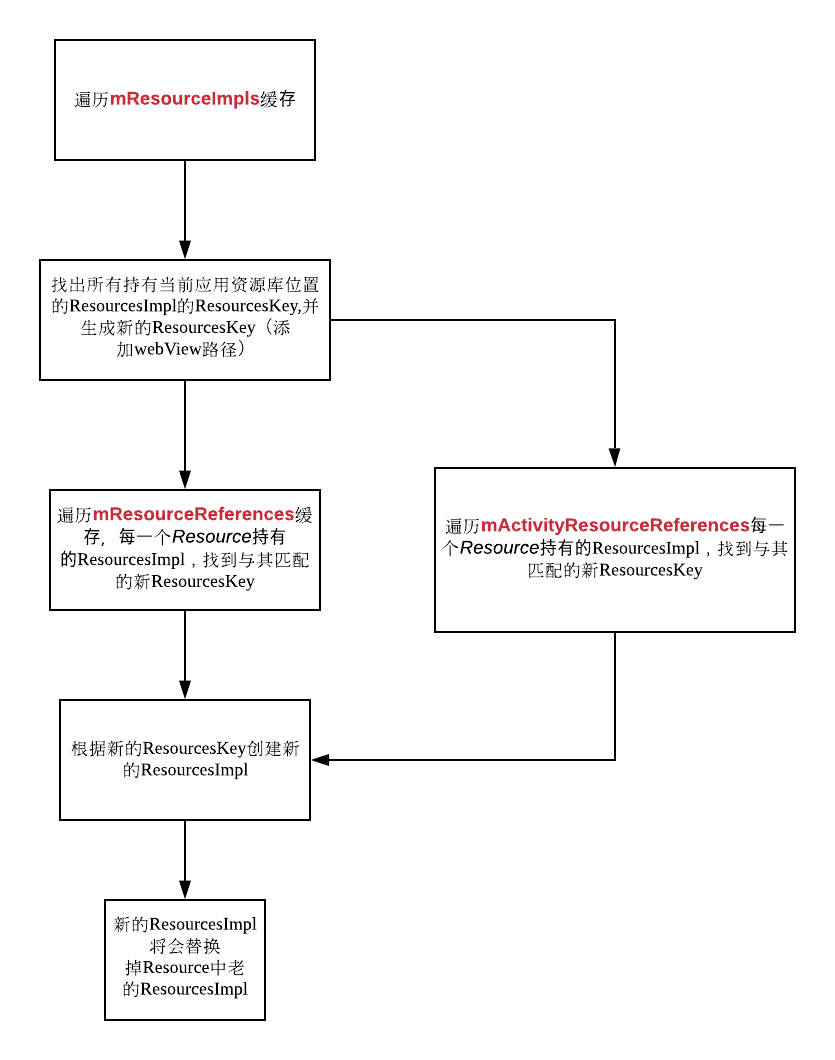
WebView就是通过这种方式,在Activity的Resource中加入了WebView的资源。
最终解决方案
这样其实我们就已经分析出在7.0以上的机器中长按WebView 因为资源缺失导致崩溃的原因了。
我们在资源替换方案中将Context的Resource替换成了我们的ProxyResources,而ProxyResources其实并没有被ResourcesManager管理,也就是说webView资源注入的时候 我们的ProxyResources并没有被更新。
了解了全部原理之后 解决方法一目了然。
见如下代码:
// step 4 将代理的Resources合并到ResourcesManager中统一管控 因为我们的ProxyResourcess的ResPath是应用的path,所以webView资源注入的时候就会同步到这个Res里面
if (Build.VERSION.SDK_INT >= Build.VERSION_CODES.N) {
synchronized (ResourcesManager.getInstance()) {
//不用担心在list中不断的添加会造成数量暴增,因为添加的是弱引用,如果页面被关闭,会自动回收
ArrayList<WeakReference<Resources>> list = Reflector.with(ResourcesManager.getInstance()).field("mResourceReferences").get();
list.add(new WeakReference<Resources>(textRepairProxyResourcess));
}
}至此,webView崩溃问题解决。
六、问题回顾
问题一:
为什么要在attachBaseContext中进行反射替换Resource?
回答:
不管替换的是Application还是Activity的mResources 一定是在attachBaseContext里面对baseContext进行Hook,直接将Activity或者Application本身进行hook是不成功的 因为Activity或者Application本身并不是Context,他只是一个ContextWapper。而ContextWapper中真正的Context其实就是在attachBaseContext时赋值的。
问题二:
既然已经替换了Activity和Application的Resource,为什么还要使用factory处理layout初始化,难道layout初始化不是使用Activity中的Resource吗?
回答:
我们对Activity或者Application的mResources进行了替换,但是如果不实现流程5中的ActivtyLifecycleCallbacks,那么XML中编写的text无法实现替换,原因在于View使用TypedArray在进行赋值的时候,并不是直接使用mResources,而是直接使用mResourcesImpl,所以直接hooke了mResources还是没用,其实mResources的getText方法也是调用mResources中的mResourcesImpl的方法。
问题三:
对于已经使用了换肤模式的app(比如说浏览器)如何做String在线更新?
回答:
只需要修改原有换肤模式使用的SkinProxyResource,并getText,getString等方法代理到在线更新的TextProxyResources上即可。
更多内容敬请关注 vivo 互联网技术 微信公众号
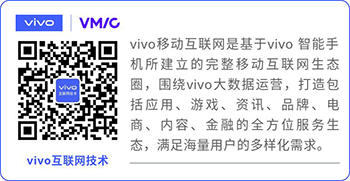
注:转载文章请先与微信号:Labs2020 联系。
Android 多语言动态更新方案探索的更多相关文章
- [原创]一种简单的cocos2d-x动态更新方案
介绍一个曾经在cocos2d-x项目中使用过的动态更新方案,这个方案简单易行,针对小的项目非常有用. 这个方案有两个核心的关键词:JSON,MD5. 原理可以简单地概括为:服务端持有所有动态更新资源文 ...
- fir.im Weekly - iOS / Android 动态化更新方案盘点
动态化更新是 App 开发必然面对的问题.在 iOS 环境下,Apple 开发者们像是" 带着手铐脚镣跳舞" ,相比之下 Android 开发者会轻松一点,有很多相关的开源框架帮助 ...
- iOS 利用 Framework 进行动态更新
http://nixwang.com/2015/11/09/ios-dynamic-update/ 前言 目前 iOS 上的动态更新方案主要有以下 4 种: HTML 5 lua(wax)hotpat ...
- Android UI:机智的远程动态更新策略
问题描述 做过Android开发的人都遇到过这样的问题:随着需求的变化,某些入口界面通常会出现 UI的增加.减少.内容变化.以及跳转界面发生变化等问题.每次发生变化都要手动修改代码,而入口界面通常具有 ...
- 移动端热更新方案(iOS+Android)
PPT资源包含iOS+Android 各种方案分析:https://github.com/qiyer/Share/blob/master/%E7%83%AD%E6%9B%B4%E6%96%B0%E5% ...
- Android C语言_init函数和constructor属性及.init/.init_array节探索
本篇文章主要介绍了"Android C语言_init函数和constructor属性及.init/.init_array节探索",主要涉及到Android C语言_init函数和c ...
- 在Android中实现service动态更新UI界面
之前曾介绍过Android的UI设计与后台线程交互,据Android API的介绍,service一般是在后台运行的,没有界面的.那么如何实现service动态更新UI界面呢?案例:通过service ...
- Android中动态更新ListView(转)
在使用ListView时,会遇到当ListView列表滑动到最底端时,添加新的列表项的问题,本文通过代码演示如何动态的添加新的列表项到ListView中.实现步骤:调用ListView的setOnSc ...
- 一步步教你为网站开发Android客户端---HttpWatch抓包,HttpClient模拟POST请求,Jsoup解析HTML代码,动态更新ListView
本文面向Android初级开发者,有一定的Java和Android知识即可. 文章覆盖知识点:HttpWatch抓包,HttpClient模拟POST请求,Jsoup解析HTML代码,动态更新List ...
- Android Handler传递参数动态更新UI界面demo
package com.example.demo_test; import android.app.Activity; import android.os.Bundle; import android ...
随机推荐
- 从零开始使用 ROS CDK 搭建云上解决方案
作者: 金湛 前言 资源编排服务ROS(Resource Orchestration Service)是阿里云提供的一项简化云计算资源管理的服务.开发者和管理员可以编写模板,在模板中定义所需的阿里云资 ...
- 2020-2021 “Orz Panda” Cup Programming Contest G题(树形结构)
题目传送门 题目大意:给点一颗包含 \(n\)个节点的无根树,有 \(m\)次询问,每次询问给出两个点 \(u\)和 \(v\),要求计算 \[\sum_{r=1}^{n}d_{r}(u,v) \] ...
- 如何将IPv4升级到IPv6?看完你就明白了
引言: 随着互联网的快速发展,IPv4(Internet Protocol version 4)已经无法满足日益增长的设备和用户数量的需求. IPv6(Internet Protocol versio ...
- C#12新功能有哪些?
前言 作为.NET 8发布会的一部分,微软于11月14日发布了C#12的新功能,这也是目前.NET的最新版本.正如之前公布的那样,最显著的改进包括了集合表达式.主构造函数.任何类型的别名以及lambd ...
- AtCoder_abc329
AtCoder_abc329 比赛链接 A - Spread A题链接 题目大意 输入一个字符串由大写字母组成的\(S\),输出\(S\)并在每一个字符之间加上空格 解题思路 随便打打就能过.jpg ...
- 关于C#接口的用法详细解答,附上案例说明!
接口 C#中的接口是一种定义了一组方法.属性和事件的类型.它只包含成员的声明,而不包含任何实现.接口可以被类通过实现的方式使用,从而使类能够具有接口定义的行为. 接口在C#中被定义为使用interfa ...
- 深入理解 Docker 核心原理:Namespace、Cgroups 和 Rootfs
通过这篇文章你可以了解到 Docker 容器的核心实现原理,包括 Namespace.Cgroups.Rootfs 等三个核心功能. 如果你对云原生技术充满好奇,想要深入了解更多相关的文章和资讯,欢迎 ...
- ngnix学习-反向代理
代理:可以理解为中间商,用来帮助事物A和事物B建立连接的桥梁. 什么是反向代理呢,其实就是反过来,反客为主大家都知道吧. 说明: 这里稍微罗嗦一下.做一个说明. 正常情况下,你是需要干什么,才去干什么 ...
- 记一次windows病毒联合排查全过程
8月2日通过态势感知平台,发现大量内部DNS服务器有恶意请求,且告警描述为:试图解析僵尸网络C&C服务器xmr-eu2.nanopool.org的地址,通过截图可以看到,用户每5分钟会定期向目 ...
- Pikachu漏洞靶场 RCE(远程命令执行/代码执行)
RCE 文章目录 RCE 概述 exec "ping" exec "eval" 概述 RCE(remote command/code execute),远程命令 ...
